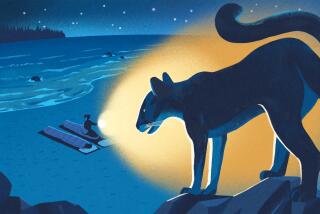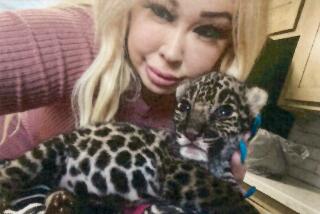Wild Animals Discover the Good Life at Mountain Menagerie
- Share via
HUDSON, Colo. — Bottle feeding a Bengal tiger cub in his kitchen, Pat Craig looked out across the acreage to his wild animal compound and recalled that the great beasts had sent him to the hospital a dozen times.
“A male jaguar went for my throat. I threw an arm up,” Craig said, pulling his left sleeve up to the shoulder to reveal a massive white scar. “He pulled it out of the socket. There were just strands holding it on.”
The jaguar decided that it wanted a water jug Craig had brought into its cage.
He is also getting ready for surgery on his right shoulder, which a black bear grabbed. The bear didn’t care to be combed out while it ate.
“You make mistakes and you learn from them,” said Craig, who has operated his Rocky Mountain Wildlife Conservation Center for 17 years after earning licenses from both the state Division of Wildlife and the U.S. Department of Agriculture.
The center cares for wild animals, many confiscated from illegal breeders, dealers or zoos. Others are found penned up in apartments, garages or basements.
The center has no funding outside of the Craig family.
“If you love these animals, it’s going to cost you--like half a million dollars over the past 15 years,” Craig said with a grin as he unlocked the outer gate to the double-fenced compound.
Lions, tigers, a jaguar, a black leopard and several mountain lions pressed close to the cyclone fences of their quarters in the circular inner compound, sounding off like a choir.
“It’s like a family. You start with one, then you have several. Once I got up to 70 animals. My niche is to spoil ‘em, so I’ve cut back down to 15 to 20,” Craig said.
First there was Freckles, a jaguar he raised since she was 10 days old, 17 years ago.
“They grow up thinking they are people. Freckles lived in the house with me for seven years. When I met my wife to be, Freckles was so jealous she wouldn’t let Shelley in the house. So we got married and I had to put Freckles outside in the compound. It took Freckles four or five years to get over it,” Craig mused as Freckles chirped and preened back and forth against him.
Tigger the Bengal tiger and twin sister Tisha were both bottle-raised from cubs by Craig and Shelley. Both roared in jealousy until they got petted and had a chat with Craig.
Craig uses what he calls “affection training.”
“We don’t declaw, neuter, spay or defang. If the cats get mad, they can kill you even if they don’t have teeth or claws.
“All we do is change our voice. If they don’t stop--you put ‘em back in the cage. They learn if they don’t stop when you change your voice, they don’t get to have fun,” such as swims in the stock pond, strolls around the farm and an occasional jack rabbit to chase, Craig said.
Just as there are all kinds of people, there is a difference in the great cat species.
“A tiger will never turn and kill me. But if a leopard gets mad, she will,” Craig said.
Mostly, wild animal news stories are the human’s fault, Craig said.
Take the visitor from another animal center who knew better but stuck his arm in Zeus’ cage and suffered a broken arm.
“He stuck his arm in Zeus’s cage and Zeus put his mouth over the guy’s arm. If he’d just stood still, Zeus would have gone on to other things, but he jerked away and Zeus thought it was a tug of war. I went into the cage--Zeus thinks I’m the king of the pride--and he just let go of the arm, thought, ‘Oh my God, I’m in trouble.’ ”
Craig teaches computer and business math at Weld Central High School. He makes about $28,000 a year and the animals’ feed bill is $30,000.
“Shelley works out at NCAR in Boulder to feed the family and pay the bills,” Craig said.
In the beginning, Craig grew up on a farm in Boulder County and liked animals but had no idea they would become his life’s work. When Craig was 17, a friend got a job in a zoo and gave him a behind-the-scenes tour.
“I was surprised how many surplus animals they had--cubs that grew up,” Craig recalled. And if the zoo couldn’t give the grown predators to other zoos, they were euthanized.
“This is nuts,” Craig said. The teenager contacted state and federal agencies and within two years had a licensed wildlife center operating on his mother’s farm north of Boulder.
Twice since then he has had to move the center because of Front Range growth.
Now, on his 160 acres southeast of Hudson, he hopes the center is settled for a while.
Good thing he likes his work: He hasn’t had a vacation in 17 years.
“I flew out to California several years ago to accept a humane award for my work. But I had to fly back the next day because the animals quit eating. Soon as I got back, they were happy, talking to me as they ate,” he said.
More to Read
Sign up for Essential California
The most important California stories and recommendations in your inbox every morning.
You may occasionally receive promotional content from the Los Angeles Times.










